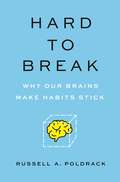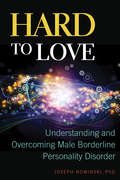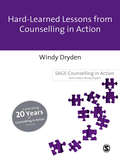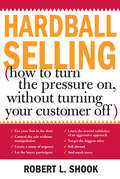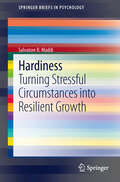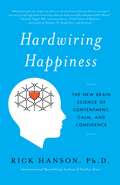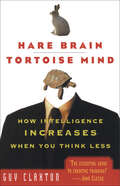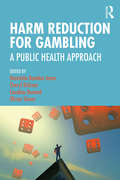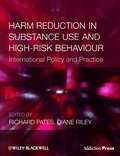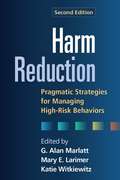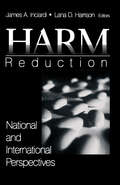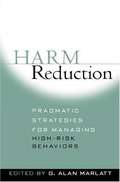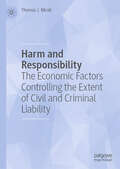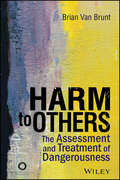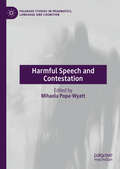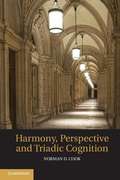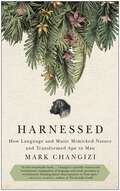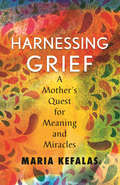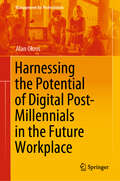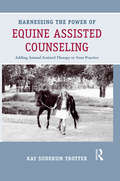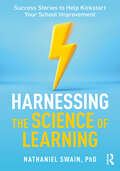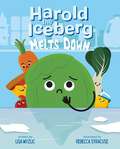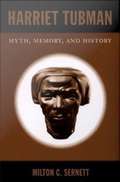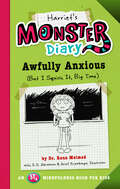- Table View
- List View
Hard to Break: Why Our Brains Make Habits Stick
by Russell A. PoldrackThe neuroscience of why bad habits are so hard to break—and how evidence-based strategies can help us change our behavior more effectivelyWe all have habits we’d like to break, but for many of us it can be nearly impossible to do so. There is a good reason for this: the brain is a habit-building machine. In Hard to Break, leading neuroscientist Russell Poldrack provides an engaging and authoritative account of the science of how habits are built in the brain, why they are so hard to break, and how evidence-based strategies may help us change unwanted behaviors.Hard to Break offers a clear-eyed tour of what neuroscience tells us about habit change and debunks “easy fixes” that aren’t backed by science. It explains how dopamine is essential for building habits and how the battle between habits and intentional goal-directed behaviors reflects a competition between different brain systems. Along the way, we learn how cues trigger habits; why we should make rules, not decisions; how the stimuli of the modern world hijack the brain’s habit machinery and lead to drug abuse and other addictions; and how neuroscience may one day enable us to hack our habits. Shifting from the individual to society, the book also discusses the massive habit changes that will be needed to address the biggest challenges of our time.Moving beyond the hype to offer a deeper understanding of the biology of habits in the brain, Hard to Break reveals how we might be able to make the changes we desire—and why we should have greater empathy with ourselves and others who struggle to do so.
Hard to Love
by Joseph NowinskiBorderline Personality Disorder (BPD) in men is often misdiagnosed and typically leads to either no treatment or the wrong treatment. This is the first book to address this under-recognized problem. It contains symptoms and causes, as well as treatment, targeted to men who suffer from BPD.Joseph Nowinski, PhD, is a clinical psychologist in private practice and the author of numerous books. His most recent books include Saying Goodbye: A Guide to Coping with a Loved One's Terminal Illness and Almost Alcoholic: Is My (Or My Loved One's) Drinking a Problem?
Hard-Earned Lessons from Counselling in Action (Counselling in Action #15)
by Windy DrydenSeminars by Professor Windy Dryden. See the man live and in action. To find out more and to book your place go to www.cityminds.com ________________________________________ SAGE celebrated the 20th Anniversary of the Counselling in Action in November 2008. To view the video - click here ----------------------------------------------------------- `This is a very honest book and should be essential reading for anyone beginning training as a counsellor. It will also be useful for experienced therapists to stimulate reflections on their own practice... to examine their work and to learn from errors. It is refreshing to witness the honesty and openness of the writers - especially so in the present culture, where many therapists set themselves up as flawless experts... I would recommend this book... it provides an informed and open discussion on the problems encountered by therapists' - Clinical Psychology Forum Counsellors often struggle in their work with clients, convinced that their more experienced colleagues have not encountered similar problems and worries. In this volume, some of Britain's leading counsellors give the lie to this myth. Writing openly and frankly, they share the painful lessons they have learned over the course of their careers as practitioners. The contributors' combined experience proves that all counsellors, no matter how expert or well-known, have made mistakes, or faced challenges, and from them have had to learn aspects about the process of counselling - the hard way. The five `lessons' from each contributor are placed in the context of the counsellor's own particular circumstances, and a concluding section in each chapter links the connecting themes that emerged throughout their learning process.
Hardball Selling
by Robert ShookStraightforward secrets and strategies for salespeople who want to join the winning top 5 percent of the sales force Get your foot in the door Control the sale without manipulation Create a sense of urgency Let the buyer participate Learn the crucial subtleties of an aggressive approach Target the biggest sales Sell abroadAnd much moreFor many companies, 20 percent of their sales force generates 80 percent of their sales volume. In this hands-on guide, Robert L. Shook, a master salesman, teaches the high-pressure strategies that mean the difference between a super seller and a salesperson. The methods spelled out in this book describe what it takes to be in the elite 5 percent.In Hardball Selling, Shook inspires all salespeople to dare to be different and master hard selling without browbeating or offending customers. Shook spent 17 years in the trenches perfecting his successful strategies. Using the four basic principles of hardball selling, he guides you through all the steps, from getting past the "gatekeeper" to the single-minded tactics necessary to close a sale."Shook's Hardball Selling is provocative and controversial--and filled with wonderful selling tips. I highly recommend it to every salesperson."--Martin D. Shafiroff, the world's No. 1 stockbroker
Hardiness
by Salvatore R. MaddiThese are turbulent times in which it becomes increasingly important to survive and thrive despite stressful circumstances. Hardiness is the pattern of attitudes and skills that provides the courage and strategies that helps people be resilient by turning potential disasters into growth opportunities and fulfillment, thereby enhancing their performance, sense of fulfillment, and health. Hardiness as the pathway to resilience under stress has become of considerable interest, it is beginning to have an influence on the emerging emphasis of positive psychology by expanding this approach beyond mere happiness, to the courage and strategies needed to make the most of difficult times. The book starts with the special value of hardiness in being resilient by not only surviving, but also thriving under stress, and thereby achieving fulfillment in living. The book then elaborates on the pattern of attitudes and skills of hardiness that form the pathway to this needed resiliency. It discusses the 30 years of validational research and practice that is available concerning hardiness. The book offers various applications of hardiness assessment and training that can contribute to a better life. These include, among others, how hardiness can be trained in school and emphasized in psychotherapy, how hardiness facilitates the intimacy and longevity of relationships, and what organizations need in order to perform successfully in these turbulent times. The book is of interest to academics, industrial and organizational psychologists, clinical psychologists, mental health professionals, and professionals in public health, social work, sociology and human resources.
Hardwiring Happiness: The New Brain Science of Contentment, Calm, and Confidence
by Rick HansonWhy is it easier to ruminate over hurt feelings than it is to bask in the warmth of being appreciated? Because your brain evolved to learn quickly from bad experiences but slowly from the good ones. You can change this. Hardwiring Happiness lays out a simple method that uses the hidden power of everyday experiences to build new neural structures full of happiness, love, confidence, and peace. Dr. Hanson's four steps build strengths into your brain-- balancing its ancient negativity bias--making contentment and a powerful sense of resilience the new normal. In mere minutes each day, we can transform our brains into refuges and power centers of calm and happiness.From the Hardcover edition.
Hare Brain, Tortoise Mind: How Intelligence Increases When You Think Less
by Guy Claxton“Backs up anecdotal studies of creativity with up-to-date Information about the latest research into brain function . . . a fascinating book.” —Anthony Storr, author of Solitude: A Return to SelfIn these accelerated times, our decisive and businesslike ways of thinking are unprepared for ambiguity and paradox, and we’ve lost our appreciation for the value of “sleeping on it.” We assume that the quick-thinking hare brain will beat out the slower intuition of the tortoise mind. But new research in cognitive science is changing this understanding of human mental processes. It suggests that patience and confusion—not rigor and certainty—are the essential precursors of wisdom.With a compelling argument that the mind works best when we trust our unconscious, or “undermind,” psychologist Guy Claxton makes an appeal that we be less analytical and let our creativity have free rein. He also encourages reevaluation of society’s obsession with results-oriented thinking and problem-solving under pressure. Packed with interesting anecdotes, a dozen puzzles to test your reasoning, and the latest related research, Hare Brain, Tortoise Mind is an Illuminating, uplifting, stimulating read that focuses on a new kind of well-being and cognition.“The essential guide to creative thinking.” —John Cleese“His multidisciplinary approach is beautifully executed.” —Kirkus Reviews“Counterintuitive . . . provocative . . . While Claxton speaks the language of cognitive science, his ideas resonate with Freud’s description of the unconscious, Buddhist concepts of the divine ground of existence and the great Romantic poets’ notions of the fount of creativity.” —Publishers Weekly
Harm Reduction for Gambling: A Public Health Approach
by Henrietta Bowden-Jones Cheryl Dickson Caroline Dunand Olivier SimonThis edited volume aims to facilitate the evolution of the new public health approach towards gambling. Bringing together the work of international experts, it gives a current overview of the field, highlighting the need for a coordinated framework of prevention and harm reduction measures to replace current "player protection" measures. Chapters begin by exploring the impact of problem gambling, looking at its effects on several levels, ranging from the individual to the family and society. Subsequently an overview of prevention and harm reduction models is presented, bringing the reader to an in-depth understanding of what a public health approach to gambling would entail. Later chapters focus on potential challenges to monitoring and evaluation, inviting the reader to envisage possible barriers towards implementation and ways of overcoming these. The book concludes with recommendations on how to take a harm reduction approach, from a political and human rights perspective. This work gives a rare synopsis of the present-day issues when considering the implementation of a harm reduction strategy for gambling. Recent work by key professionals is presented in order to encourage further developments in this ever-changing domain. Such issues will be relevant to all those with an interest in the field of problem gambling, from clinicians, students and healthcare professionals, to politicians.
Harm Reduction in Substance Use and High-Risk Behaviour (Addiction Press)
by Richard Pates Diane RileyHarm Reduction is a philosophy of public health intended as a progressive alternative to the prohibition of certain potentially dangerous lifestyle choices. Recognising that certain people always have and always will engage in behaviours which carry risks, the aim of harm reduction is to mitigate the potential dangers and health risks associated with those behaviours. Harm Reduction in Substance Use and High-Risk Behaviour offers a comprehensive exploration of the policy, practice and evidence base of harm reduction. Starting with a history of harm reduction, the book addresses key ethical and legal issues central to the debates and developments in the field. It discusses the full range of psychoactive substances, behaviours and communities with chapters on injecting, dance drugs, stimulant use, tobacco harm reduction, alcohol use and sex work. Written by an international team of contributors, this text provides an essential panorama of harm reduction in the 21st century for educators and researchers in addiction and public health, postgraduate students and policy makers.
Harm Reduction, Second Edition
by G. Alan Marlatt Mary E. LarimerFrom addictions treatment pioneer G. Alan Marlatt and associates, this is the authoritative work on harm reduction: its principles, strategies, and practical applications. Contributors review programs that have been developed and tested for a range of high-risk behaviors, including problem drinking, tobacco use, illicit drug use, and risky sexual behavior. Flexible, tailored, culturally competent treatment approaches are described for marginalized and underserved communities. The volume also explores philosophical and policy-related debates surrounding this growing movement. New to This Edition, Reflects significant advances in research and clinical practice, as well as increasing professional acceptance of the harm reduction model.*Chapters on the current status of the field, applications to psychotherapy, and treatment of dual disorders. Chapters on additional populations (adolescent drinkers and Hispanic/Latino and Asian American substance users) and an additional substance (cannabis).
Harm Reduction: National and International Perspectives
by James A. Inciardi Dr Lana D. HarrisonIn this volume, international contributors discuss the philosophical basis and history of harm reduction policies and examine their outcomes. They also cover controversial topics related to harm reduction especially conflicts between the public health system, where most programs are located, and a worldwide criminal justice system that further marginalizes drug users. The book describes programs from the United States, the United Kingdom, Canada, Brazil, The Netherlands, Switzerland and Australia.
Harm Reduction: Pragmatic Strategies for Managing High-Risk Behaviors
by G. Alan MarlattHarm reduction principles and strategies are designed to minimize the destructive consequences of illicit drug use and other behaviors that may pose serious health risks. The first major harm reduction text, this provocative and timely volume examines a wide range of current applications, from needle exchange and methadone maintenance programs, to alternative alcohol interventions and HIV/AIDS prevention campaigns. Insight is also offered into the often contentious philosophical and policy-related debates surrounding this growing movement.
Harm and Responsibility: The Economic Factors Controlling the Extent of Civil and Criminal Liability
by Thomas J. MiceliRisk is an ever-present feature of life in a complex world, and it is important for societies to manage it in a just and efficient manner. One way to reduce risk is to assign responsibility for the associated harm. In this book, economist Thomas J. Miceli examines harm and responsibility from an economic perspective. The book focuses on how responsibility affects people’s incentives to refrain from causing unnecessary harm to achieve what economists call optimal deterrence. Secondarily, it is concerned with the quest for justice. Defining this is part of the journey. Does it mean compensating victims for unavoidable losses? Does it involve punishing wrongdoers in proportion to the harm they have caused? Is there a clear answer? The book addresses these questions and more, explaining how, in some cases, these objectives will align with deterrence and in others they will not. The book discusses the ways that the law, tempered by religious and social norms, strikes a balance between these goals. The principal areas of law that assign legal responsibility are tort law (for accidental harms) and criminal law (for intentional harms). There exist vibrant economic theories of both, and this volume draws on this literature. One theme that emerges is the role of causation in determining responsibility. Attributing responsibility for a given harm to the party that caused it seems both morally just (because it embodies personal responsibility), and economically desirable (because it achieves deterrence in the most direct manner). And yet the law departs from this prescription in any number of ways, both by limiting the responsibility of some who caused harm and by expanding responsibility to some who did not. The book offers readers coherent economic explanations for these departures from a purely causal basis for legal responsibility. Author Thomas J. Miceli clarifies causation as reciprocal in nature and therefore not a uniquely defined concept. This means that when an action by A causes harm to B, the question is not how to restrain A but rather: whether A has the legal right to take the action in question or whether B has the right to prevent it. There will be a harm either way; the relevant question is which party should bear it. This insight ultimately leads to the fundamental problem of defining harm. In most conflicts this can be straightforward—as when A punches B—but in others it is more challenging. For example, when does free speech become hate speech? Where is the line drawn? The book concludes by drawing out the implications of this fundamental ambiguity over the meaning of harm, what that means for the law, and what economic theory has to say about it.
Harm to Others: The Assessment and Treatment of Dangerousness
by Brian Van BruntHarm to Others offers students and clinicians an effective way to increase their knowledge of and training in violence risk and threat assessment, and it also provides a comprehensive examination of current treatment approaches. Although the text includes many examples from K–12 and college/university settings, which are particularly relevant for mental health professionals in school settings, the underlying concepts and suggestions are useful for counselors, psychologists, and social workers who face these issues in their daily practice. In an easy-to-understand, jargon-free manner, Dr. Van Brunt shares his observations, extensive clinical expertise, and the latest research on what clinicians should be aware of when performing risk and threat assessments. In addition, he offers numerous examples from recent mass shootings and rampage violence to help explain the motivations and risk factors of those who make threats. Two detailed case examples are presented to illustrate key concepts related to assessing dangerousness. Treatment options are then described, using a variety of diverse case studies to demonstrate concrete approaches for clients who have been identified as at risk for violence following a threat assessment. *Requests for digital versions from the ACA can be found on wiley.com. *To request print copies, please visit the ACA website here. *Reproduction requests for material from books published by ACA should be directed to permissions@counseling.org.
Harmful Speech and Contestation (Palgrave Studies in Pragmatics, Language and Cognition)
by Mihaela Popa-WyattThis edited book explores how harmful speech works, how it can be used to change societies in bad ways and how we can defend against it. Harmful speech comes in a variety of forms, including hate speech, dehumanizing speech, misogynistic speech, derogatory speech, misgendering, marginalizing speech, and much more. What is common to all these types of speech is that they don’t just offend but seek to harm members of vulnerable groups, so that they feel humiliated, attacked, denigrated, silenced, and dehumanised. These harms are not confined to the conversation in which such speech is used, but may involve various downstream effects such as moral, social, and epistemic harms. Harmful speech may also shift social norms by changing people’s opinions and ultimately changing norms about how targets ought to be treated. Harmful speech uses this effect to establish and maintain oppressive norms, entrench hierarchies and shape power relations. The contributions in this volume examine the mechanisms underlying various forms of harmful speech and possible responses and remedies. They combine a variety of tools and perspectives, including philosophy of language, linguistics, ethnography, with a particular focus on issues in the semantics/pragmatics of derogatory expressions, speech acts and conversational dynamics. The chapters bring these conversations together and highlight the ways in which philosophers of language have sought to build bridges in recent years with social and political philosophy concerned with the nature of oppression and responses to it. These topics offer the opportunity for a valuable integration of insights from different perspectives.
Harmony, Perspective, and Triadic Cognition
by Norman D. CookThe big question in the science of psychology is: Why is human cognition and behavior so different from the capabilities of every other animal species on Earth - including our close genetic relations, the chimpanzees? This book provides a coherent answer by examining those aspects of the human brain that have made triadic forms of perception and cognition possible. Mechanisms of dyadic association sufficiently explain animal perception, cognition, and behavior but a three-way associational mechanism is required to explain the human talents for language, tool-making, harmony perception, pictorial depth perception, and the joint attention that underlies all forms of social cooperation.
Harnessed: How Language and Music Mimicked Nature and Transformed Ape to Man
by Mark ChangiziThe scientific consensus is that our ability to understand human speech has evolved over hundreds of thousands of years. After all, there are whole portions of the brain devoted to human speech. We learn to understand speech before we can even walk, and can seamlessly absorb enormous amounts of information simply by hearing it. Surely we evolved this capability over thousands of generations. Or did we? Portions of the human brain are also devoted to reading. Children learn to read at a very young age and can seamlessly absorb information even more quickly through reading than through hearing. We know that we didn't evolve to read because reading is only a few thousand years old. In Harnessed, cognitive scientist Mark Changizi demonstrates that human speech has been very specifically &“designed" to harness the sounds of nature, sounds we've evolved over millions of years to readily understand. Long before humans evolved, mammals have learned to interpret the sounds of nature to understand both threats and opportunities. Our speech—regardless of language—is very clearly based on the sounds of nature. Even more fascinating, Changizi shows that music itself is based on natural sounds. Music—seemingly one of the most human of inventions—is literally built on sounds and patterns of sound that have existed since the beginning of time. From Library Journal: "Many scientists believe that the human brain's capacity for language is innate, that the brain is actually "hard-wired" for this higher-level functionality. But theoretical neurobiologist Changizi (director of human cognition, 2AI Labs; The Vision Revolution) brilliantly challenges this view, claiming that language (and music) are neither innate nor instinctual to the brain but evolved culturally to take advantage of what the most ancient aspect of our brain does best: process the sounds of nature ... it will certainly intrigue evolutionary biologists, linguists, and cultural anthropologists and is strongly recommended for libraries that have Changizi's previous book." From Forbes: &“In his latest book, Harnessed, neuroscientist Mark Changizi manages to accomplish the extraordinary: he says something compellingly new about evolution.… Instead of tackling evolution from the usual position and become mired in the usual arguments, he focuses on one aspect of the larger story so central to who we are, it may very well overshadow all others except the origin of life itself: communication."
Harnessing Grief: A Mother's Quest for Meaning and Miracles
by Maria J. KefalasThe inspiring story of a mother who took unimaginable tragedy and used her grief as a force to do good by transforming the lives of others.When Maria Kefalas's daughter Calliope was diagnosed with a degenerative, uncurable genetic disease, the last thing Maria expected to discover in herself was a superpower. She and her husband, Pat, were head over heels in love with their youngest daughter, whose spirit, dancing eyes, and appetite for life captured the best of each of them. When they learned that Cal had MLD (metachromatic leukodystrophy), their world was shattered. But as she spent time listening to and learning from Cal, Maria developed the superpower of grief. It made her a fearless warrior for her daughter. And it gave her voice a bell-like clarity--poignant and funny all at once.This superpower of grief also revealed a miracle--not the conventional sort that fuels the prayers of friends and strangers but a realization that, in order to save themselves, Maria and Pat would need to find a way to save others. And so, with their two older children, they set out to raise money so that they, in their son PJ's words, could "find a cure for Cal's disease." They had no way of knowing that a research team in Italy was closing in on an effective gene therapy for MLD. Though the therapy came too late to help Cal, this news would be the start of an unexpected journey that would introduce Maria and her family to world-famous scientists, brilliant doctors, biotech CEOs, a Hall of Fame NFL quarterback, and a wise nun, and it would also involve selling 50 thousand cupcakes. They would travel to the FDA, the NIH, and the halls of Congress in search of a cure that would never save their child. And their lives would become inextricably intertwined with the families of 13 children whose lives would be transformed by the biggest medical breakthrough in a generation.A memoir about heartbreak that is also about joy, Harnessing Grief is both unsparing and generous. Steeped in love, it is a story about possibility.
Harnessing the Potential of Digital Post-Millennials in the Future Workplace (Management for Professionals)
by Alan OkrosThis book offers strategic leaders with essential information for their most important role: the change management function of positioning the organization for success into the future. To do so, leaders need to sort through a myriad of forecasts, predictions and weak indicators of change to make timely decisions. This volume addresses the most critical factor for future success: people and, specifically, harnessing the potential the current youth cohort will bring when they join the full-time workforce. Drawing on multi-disciplinary analyses by 37 researchers, the book presents an integrative assessment of the characteristics that those in the current youth cohort are likely to bring to the workplace. The focus is on those born after 2005 with an examination of the implications of this cohort being raised from birth immersed in an increasingly omnipresent digital environment which extends far beyond social media. The authors see the coming ‘digital tsunami’ as creating disruptive effects across major elements of our economy and even society however optimistically conclude that the digital environment and the development of 21st Century skills in schools will equip the next generation with essential competencies, attitudes, social skills and work goals. The key to harnessing the potential of this generation will be to modify current human resources and workplace practices which will mean sweeping away much of the ‘boomer’ legacy that this cohort has imprinted on organizations. To assist leaders, the book goes beyond presenting a rich portrait of who these youth may become by providing practical recommendations for the changes that need to start now in order to position the organization to benefit from what they will bring. As the astute strategic leader knows: objects in the future can be closer than they appear.
Harnessing the Power of Equine Assisted Counseling: Adding Animal Assisted Therapy to Your Practice
by Kay Sudekum TrotterThis book will help licensed professional counselors incorporate Equine Assisted Counseling (EAC) into their practices, even those who have little prior experience working with horses. It provides a strong research foundation for understanding the efficacy of equine assisted interventions and the potentially powerful impact that a horse can have in creating a new counseling dynamic. Chapters address using horses to help clients dealing with various traumas and abuse, anxiety, depression, atypical behaviors, and social skills and communication issues. Additionally, a chapter by the internationally renowned "horse whisperer" Pat Parelli offers a look at EAC from the horse’s point of view and demonstrates developing a relationship with a therapy horse in a positive, safe, and respectful manner. Counselors will find this a valuable resource for understanding and utilizing EAC as a new resource in their own practices, as will students seeking to learn about this innovative approach.
Harnessing the Science of Learning: Success Stories to Help Kickstart Your School Improvement
by Nathaniel SwainDrawing together the worlds of classroom practice, school leadership and scientific research, this is an essential how-to guide for initiating and maintaining a school improvement journey based on the science of learning.What we now know about learning and teaching is vast; yet often, wading through the thousands of articles and books on this subject can leave even the most seasoned educator overwhelmed. This guide instead offers a distillation of key understandings—for teaching, literacy, mathematics, curriculum and implementation—to launch your school improvement work.Harnessing the Science of Learning also features contributions from thought leaders across the fields of learning sciences and educational practice: Pamela Snow, Tanya Serry, Zach Groshell, Reid Smith, Toni Hatten-Roberts, Simon Breakspear, Katie Roberts-Hull, David Morkunas, Steven Capp, Shane Pearson and Eamon Charles.This book illustrates practical ways to harness this knowledge, using a series of exemplary school case studies. These insightful narratives of transformation are interwoven with summaries of powerful teaching practices, forming a roadmap to drive improvement.In this volume, you will learn how even discrete changes in a school can have marked impacts. It is suitable for those already versed in such principles, as well as anyone curious to plunge into what the science of learning has to offer.
Harold the Iceberg Is Not a Super Food (Harold the Iceberg #2)
by Lisa Wyzlic"The perfect picture book for anxious kids." —Romper, on Harold the Iceberg Melts DownWhen Harold first meets Kayla, he’s in awe. She’s tall and strong, has glorious, full leaves and is always ready to help with a smile. But the more Harold thinks about how super Kayla is, the more he feels like he’s not good enough, no matter how much he wants to help others. Harold is not a super food.As his worries continue to grow, it’ll be up to his friends to show Harold that not only is he enough, but that he’s a super helper in his own special ways.Written by Lisa Wyzlic and whimsically illustrated by Rebecca Syracuse, Harold the Iceberg’s second adventure is about finding ways to lift up your community by first lifting up yourself and those closest to you.
Harold the Iceberg Melts Down (Harold the Iceberg #1)
by Lisa WyzlicAccompanied by Rebecca Syracuse’s bold, whimsical artwork, Lisa Wyzlic’s debut picture book Harold the Iceberg Melts Down is all about the importance of friendship and self-care, perfect for any young reader worried about their planet’s future.Harold is an iceberg... lettuce. (But he doesn't realize the "lettuce" part because part of his sticker has ripped off.) So one day when he sees a documentary about how the icebergs are melting, Harold starts to worry, thinking that he's melting too.As his anxiety grows and grows, and he tries to find a way to stop melting, his fellow food friends try to help him cool down in a different way.
Harriet Tubman: Myth, Memory, and History
by Milton C. SernettHarriet Tubman is one of America's most beloved historical figures, revered alongside luminaries including Abraham Lincoln and Frederick Douglass. Harriet Tubman: Myth, Memory, and History tells the fascinating story of Tubman's life as an American icon. The distinguished historian Milton C. Sernett compares the larger-than-life symbolic Tubman with the actual "historical" Tubman. He does so not to diminish Tubman's achievements but rather to explore the interplay of history and myth in our national consciousness. Analyzing how the Tubman icon has changed over time, Sernett shows that the various constructions of the "Black Moses" reveal as much about their creators as they do about Tubman herself. Three biographies of Harriet Tubman were published within months of each other in 2003-04; they were the first book-length studies of the "Queen of the Underground Railroad" to appear in almost sixty years. Sernett examines the accuracy and reception of these three books as well as two earlier biographies first published in 1869 and 1943. He finds that the three recent studies come closer to capturing the "real" Tubman than did the earlier two. Arguing that the mythical Tubman is most clearly enshrined in stories told to and written for children, Sernett scrutinizes visual and textual representations of "Aunt Harriet" in children's literature. He looks at how Tubman has been portrayed in film, painting, music, and theater; in her Maryland birthplace; in Auburn, New York, where she lived out her final years; and in the naming of schools, streets, and other public venues. He also investigates how the legendary Tubman was embraced and represented by different groups during her lifetime and at her death in 1913. Ultimately, Sernett contends that Harriet Tubman may be America's most malleable and resilient icon.
Harriet's Monster Diary: Awfully Anxious (But I Squish It, Big Time) (Monster Diaries #3)
by Raun Melmed S.E. AbramsonMeet Harriet, a lovable monster who is just sick at the thought of giving a report in front of her class! Her heart pounds, her chest gets tight, and her stomach twists in painful knots. She can't even bear to get started on it! What is she going to do?In the same humorous spirit of Diary of a Wimpy Kid comes Harriet's Monster Diary: Awful Anxiety (But I Squish It, Big Time). Using the “furmometer” and ST4 techniques developed by Dr. Raun Melmed of the Melmed Center in Arizona, Harriet's Monster Diary teaches kids how to monitor how they feel and respond to stressful situations. Harriet’s hilarious doodles and diary entries chronicle her delightful adventures, misadventures, and eventual triumph in a funny, relatable way. It’s the one book that stressed kids will want to calm down to read!Harriet's Monster Diary also includes a resource section to help parents and teachers implement Dr. Melmed’s methods, plus ST4 reminders that kids can remove, color, and place around the house.
